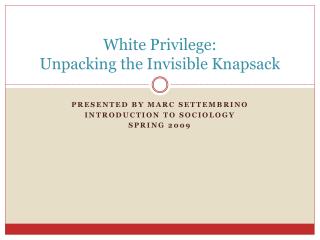


^ Milstein, Tema Pileggi, Mairi Morgan, Eric (2017).^ "What Does 'Cultural Appropriation' Actually Mean?"."How Legos helped build a classroom lesson on white privilege". ^ a b Bascaramurty, Dakshana (October 16, 2017)."How Tumblr Taught Social Justice to a Generation of Teenagers". ^ "Educator: Time to unpack your invisible knapsack of privileges".Diversity hasn't helped white players and coaches understand racism". ^ a b "White People Talk About Their White Privilege".^ Friedersdorf, Conor (September 17, 2019)."White people have a race - but everyone flips out when we talk about it". "Deborah Pearson: 'It's about using my privilege to amplify other voices' ". "City's public schools join fight against 'white power' ". "10 things you should know about white privilege". ^ Pearson, Luke Verass, Sophie (January 7, 2019)."At New York Private Schools, Challenging White Privilege From the Inside". ^ a b "Beto O'Rourke and the proliferation of white privilege accusations".The essay has inspired "Privilege Walks", workshops, and similar activities to help students concretely identify their privileges, though McIntosh herself has disavowed the walks as "too simple for complex experiences relating to power and privilege" and thus as "counterproductive". Conor Friedersdorf has recommended the essay's inclusion in college curriculums. In 2017, a high school in Caledon, Ontario discussed the essay as part of an 11th Grade anthropology class. In 2016, some New York City public schools assigned the reading to high school students. The essay has become one of the key teaching resources in the study of white privilege in North America. In 2018, artwork and studies inspired by the essay had become popular in social justice sections of social media, such as Tumblr. It has been cited as responsible for the mainstreaming of discussion of white privilege, becoming a "staple of discussions about bias" in society. The Atlantic has written that the intention behind the essay was to inspire "self-reflection, enhancing their capacity for empathy and compassion." It has been described by Vice as one of the most authoritative texts on the subject of white privilege, and The Harvard Gazette have called it a "groundbreaking article" and the most important of McIntosh's academic career. These have been described as "small benefits that white Americans enjoy every day." The essay features 50 of McIntosh's insights into experiential white privilege, listed numerically.McIntosh's outlines "invisible systems" at work, as well as the main theme of an "invisible package of unearned assets", examined in the form of a metaphorical knapsack. It covers 50 examples, or hidden benefits, from McIntosh's perspective, of the privilege white people experience in everyday life. " White Privilege: Unpacking the Invisible Knapsack" is a 1989 essay written by American feminist scholar and anti-racist activist Peggy McIntosh. This article is about the essay by Peggy McIntosh.


 0 kommentar(er)
0 kommentar(er)
